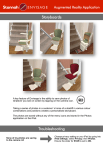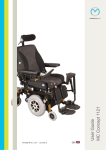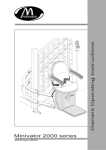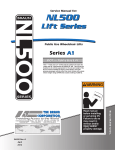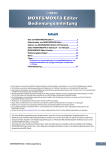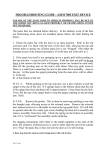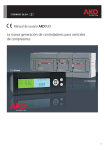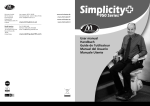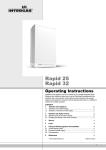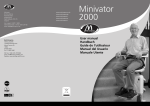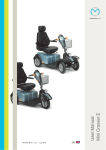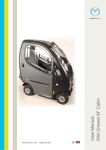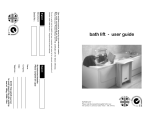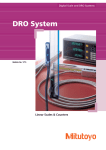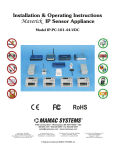Download SImplIcIty+ - Handicare AS
Transcript
INSTALLATION MANUAL + Simplicity MANISS950 Minivator Simplicity+ installation manual Smart Seat Pre-installation check list 1Check that all of the required components are available. You should have 7 boxes. These are colour coded so that identification of any handed components is simple. The table below shows the colour of the boxes that you require. COMPONENT Left hand Right hand Smart Seat base PURPLE GREEN Smart Seat back Power pack Fitting kit Smart Seat Upholstery BLACK Bottom Track Section Top Track Section e.g. a left hand lift comprises 1 purple and 6 black boxes; a right hand lift comprises 1 green and 6 black boxes. 2 Installation tools required • Loading toggle • 2.5mm Allen key • Shorting links • 3mm Allen key • 10mm spanner • 4mm Allen key • 10mm socket • 5mm Allen key • Narrow nosed pliers • 6mm Allen key • 13mm socket (ball ended) • 17mm socket • 8mm Allen key • Side cutters • Spirit level • 8mm spanner • Handlamp • 13mm spanner • Hacksaw • 17mm spanner • Tin snips • No. 2 Pozi-drive Note: The installation engineer must check with Minivator for the latest installation manual issue number. Issue No of this manual is 2011-1 ORIGINAL LANGUAGE ENGLISH 2 MINIVATOR SIMPLICITY+ INSTALLATION MANUAL Track assembly Track assembly Before beginning the installation please ensure that the track is the required length. Refer to Appendix 5 for details. Items required:Tools required: • Fit kit • 2.5mm Allen key Splice bars x 3 • 3mm Allen key Track ends cap x 1 • 6mm Allen key Red bag • 13mm Spanner 8 x bolts • Hacksaw 4 x grub screws • Tin snips Final limit stops x 1 End stops x 1 Mounting feet x 3 • Top track section x 1 • Bottom track section x 1 1Position the bottom section of the track (2m) on the stairs with the splice holes at the top (Figure 1). Regardless of the hand of the lift the rack should always be on the left hand side of the track when looking up the stairs. 2Bolt in the splice bars to the bottom section of track extrusion (Figure 2) using 2 grub screws for the top splice bar and the 4 bolts in the bottom splice bars (from the red fittings bag). Figure 1 Figure 2 Figure 3 MINIVATOR SIMPLICITY+ INSTALLATION MANUAL 3 Track assembly Note: Ensure that the splice bars are positioned in the track in the correct orientation. The splice bar has three flat faces and one sloping face. The sloping face MUST be positioned against the sloping face on the extrusion (Figure 3). 3If the track is less than 2000mm and cutting to length on site: aRemove the charge spring contact (Figure 4). bUsing the loading tool, push the plastic carrier strip up the top section of track (Figure 5). Figure 6 Figure 4 Figure 5 4 MINIVATOR SIMPLICITY+ INSTALLATION MANUAL Figure 7 Track assembly cAt the top end of the top section use a hacksaw to remove the excess plastic carrier strip (Figure 6). dCarefully replace the charge spring contact. 4Position the top section of track adjacent to the bottom section of track (Figure 7). 5Offer up the adjacent track section in the normal way. Run the two core top safety edge/end cap cable to the top of the track. Bolt together the two track sections as normal. Figure 8 6Bolt both sections of track together (Figure 8). The bolts should be tightened in sequence: a left bottom b centre bottom c right bottom d left top e centre top f right top Repeat this process until the bolts are all secure (torque setting 8-9Nm). 7Push the plastic carrier strip down from the top track section to meet the plastic carrier strip in the bottom section. The plastic carrier strip will finish 10mm short of the end of the track. Carefully feed down the copper charge strip (Figure 9) and trim to the same length as the plastic carrier strip. Figure 9 8Check that the charge strip has made proper contact with the spring contact at the bottom of the track (Figure 4). Note: Ensure that the track is connected with all faces level so that no step is present in the joint. Note: Excessive force can damage and prevent the spring contact from making a proper connection. 9Slide the three mounting feet on to the track (Figure 10). Note: See page 8 for Slide Track positioning. Figure 10 MINIVATOR SIMPLICITY+ INSTALLATION MANUAL 5 Track assembly 10Position the feet in the following way (Figure 11): aThe top foot should be positioned on the last tread. bThe middle foot should be positioned immediately next to the spliced joint. If the top section is longer than the bottom then the foot should be ABOVE the spliced joint, if not, then the foot should be BELOW the spliced joint. cThe bottom foot should be positioned on the first tread. 11Loosely tighten the feet to stop them from moving. The feet will help to stop the track from moving on the stairs while the next steps are performed. Note: If the stairlift is being fitted to a staircase with open bannisters on the bannister side they must be covered with a solid sheet material for safety. 12If the power supply is: a At the top of the track: Figure 11 •Feed the long power cable with the push terminals from the power supply through the large cavity in the assembled track. bAt the bottom of the track: •Bring the long power cable with the push terminals from the power supply to the bottom of the track. 13Slide the track up the stairs and position it centrally to give you sufficient room to work comfortably at the bottom of the stairs. 14Connect the positive push terminal (WHITE CABLE) to the red push terminal attached to the busbar (Figure 12). 15Connect the negative push terminal (BLACK CABLE) to the push terminal from the track. Figure 12 6 MINIVATOR SIMPLICITY+ INSTALLATION MANUAL 16Fit the bottom end stop and final limit stop to the bottom of the track only (Figure 13). Track assembly Note: The shorter (square ended stop) must be fitted in the top channel – failure to do this correctly could damage the lift. 17Fit the bottom end cap to the track (Figure 14), ensuring that the power supply cable is fed through the channel provided so that it exits the track on the WALL side. 18Tighten the grub screws to secure the end cap to the track. Figure 13 19Now slide the bottom end stop and final limit stop so that they sit against the positioning extensions of the end cap and then tighten the grub screws (Figure 14). Note: The grub screws on the end cap should not be over tightened. Figure 14 MINIVATOR SIMPLICITY+ INSTALLATION MANUAL 7 Feet positioning Feet positioning Items required:Tools required: • None • 13mm Spanner • 13mm Socket 1Slide the track to the side of the stairs that it will be finally located to position the feet. The feet should be positioned so that they are touching the stringer (Figure 15). Note: If the stringer does not extend to the tread, i.e. it overhangs the staircase, use a plumb line to mark a position on the stairs. The feet should all be positioned in this way. Third/ last foot Splice Figure 15 Second foot Figure 16 8 MINIVATOR SIMPLICITY+ INSTALLATION MANUAL Figure 17 Feet positioning 2With the end of the track positioned so that it is just touching the floor ensure that the feet are still positioned on the stair treads as previously described (Figure 11), i.e: aThe top foot should be positioned on the last tread. bThe middle foot should be positioned immediately above the spliced joint. cThe bottom foot should be positioned on the first tread. 3 Tighten the bolts on the feet (Figure 16). Slide Track only Figure 18 4Position the first (fixed) foot on the second step of the staircase. Then position and loosely fix the second foot to the stairs, two full steps below the track splice point (or the end of the track for a single section track), to allow clearance when the Slide Track moves (Figure 17). The track should be approximately 25mm from the nose of the stairs. 5Position the remaining feet on the steps and loosely fix them to the stairs. The last foot needs to be positioned two full steps down from the top of the stairs, whilst the third foot should be as close as possible to the splice. 6The feet should sit as close as possible to the stringer (Figure 18). Figure 19 Note: Track may need to be moved out to ensure seat clears. 7If the track was not delivered pre-cut to the correct length, trim the communications busbar to the appropriate length to accommodate the top end cap (Figures 4, 5 and 19). 8Clip on the stringer-side roller covers using the tacks provided. Then, with the track in approximately the correct position, put a screw into each foot to stabilise the track (Figure 20). Figure 20 MINIVATOR SIMPLICITY+ INSTALLATION MANUAL 9 Loading the power pack Loading the power pack 12Fit the top end cap to track and tighten the grub screws to secure it. Items required:Tools required: • Power pack • Loading toggle • Fit Kit • Shorting links End cap x 1 Green bag Wood screws x 12 Final limit stops x 1 End stops x 1 Busbar pickup loading tool (x 2 for Slide Track) Note: The grub screws on the end cap should not be over tightened. If the power supply is being connected at the top of the stairs, ensure that the power supply cable is fed through the channel provided so that it exits the track on the WALL side. 13Now slide the top end stop and final limit stop so that they sit against the positioning extensions of the end cap and then tighten the grub screws. 1Carry the power pack box to the top of the stairs. 2 Unpack the power pack from its box carefully. 3Move the track away from the stringer slightly, around 150mm, to give you more room to work. 4Remove the blanking plates from the side of the power pack that will be facing the stairs (Figure 21). 5Connect the limit switch shorting links (Figures 21 and 22). 6Connect the driving links (or loading toggle) (Figures 21 and 22). 7Ensure that the busbar pickup loading tool is correctly positioned (Figure 23). Figure 21 8Carefully slide the power pack onto the track until the drive pinion meets the beginning of the rack (Figure 24). 9Turn the power pack on from the main switch on the lower safety edge (Figure 25). 10Using the loading driving links or toggle switch (Figure 26), drive the power pack onto the track. The power pack should be driven to a position approximately half way between the top and middle foot. 11Fit the top end stop and final limit stop to the top of the track (Figure 27). Note: The shorter (square ended stop) must be fitted in the top channel – failure to do this correctly could damage the lift. Figure 22 10 MINIVATOR SIMPLICITY+ INSTALLATION MANUAL Loading the power pack Figure 23 Figure 26 Figure 24 Figure 27 Figure 25 Figure 28 MINIVATOR SIMPLICITY+ INSTALLATION MANUAL 11 Loading the power pack Note: The final limit stop jacking screw should only be used if the final limit is not being recognised when the pack is run on the track. Tighten one full turn max after contact (Figure 28). Slide Track installations 14When loading the pack take care to correctly position the two busbar pickup loading tools (Figure 29). 15In order to load the pack dipswitch 2 on the main PCB must be set to the OFF position. Once loaded this dipswitch should be returned to the ON position to enable the Slide Track (see wiring diagrams). Figure 29 Note: Do not drive the power pack in the UP direction until the top end cap has been fitted. The busbar may move and lose contact with the spring at the bottom of the track. 16Connect the power supply to the ring main or fused spur. A 400mm long “lazy loop” must be left by the stringer near the point under the centre of the track where the power cable enters the track. This is to allow slack for the Slide Track’s travel (Figure 30). 17Connect the top track safety edge assembly (active end cap) remembering to attach the additional wires (Figure 31). Figure 30 Figure 31 12 MINIVATOR SIMPLICITY+ INSTALLATION MANUAL Fitting the front chassis Fitting the front chassis to the power pack Items required:Tools required: • Front chassis • Side cutters • 6mm Allen key • 8mm Allen key • Spirit level Two cover plates and various front chassis bolts and fixings should be packed with the front chassis assembly including the safety bolt and four seat back bolts (Figure 32). Before fitting the front chassis feed the loom through the tear shaped cover plate and then attach it to the power pack (Figure 33). Figure 33 1Depending upon the hand of the stairlift being fitted, remove the appropriate pair of knock-outs (Figure 34 – left hand shown). 2Gently pull down the footplate to get access to the panel. 3Ensure that the loom from the pack is correctly positioned and does not interfere with the underpan safety edge (Figure 35). 4Fit the fixing block, bolts and spacers to the front chassis. Figure 34 Figure 32 Figure 35 MINIVATOR SIMPLICITY+ INSTALLATION MANUAL 13 Fitting the front chassis 5Offer the seat chassis to the power unit, and using the bolts and spacers secure the seat chassis to the power unit, ensuring that the chassis is in the correct vertical alignment (Figure 36). Note: The power unit has an arched slot on the seat chassis interface, to set the angle of the seat and footplate. Note: Use a spirit level positioned on the top of the front chassis, or on the footplate, to ensure that correct alignment is achieved. 6Fit the safety bolt (Figure 37). This needs to be left loose enough to allow the rear cover to pass behind it. Figure 36 Note: On left hand installations on staircases steeper than 38° the alternative safety bolt position must be used (Figure 38). Figure 37 Figure 38 14 MINIVATOR SIMPLICITY+ INSTALLATION MANUAL Fitting the seat base Fitting the seat base Items required:Tools required: • Seat base • 10mm socket • Cover plate • 13mm socket • 2 x clips • Narrow nosed pliers • 6mm Allen key 1Depending upon the hand of the stairlift being fitted, remove the appropriate knock-outs from the chassis top rear cover (Figure 39 – Left hand shown). Refer to the table below for the number of knock-outs to be removed for the client height. Required seat to footplate height (mm) 540 515 490 465 440 430 Figure 39 Knock-outs to be removed 1 2 3 4 5 5 2Load the seat base and feed the two seat post retaining bolts through the washers and the seat stems into the bottom front chassis; selecting the appropriate seat height for the client by using the holes corresponding to the height that is required (Figure 40). Figure 40 3Tighten the seat post stabilising bolts (Figure 41), and tighten the safety bolt. 4Remove the lowest of the available central knockouts from the top rear cover and feed through the main pack loom (Figure 42). 5Using the clips provided (Figure 43) fit the cover plate to the front chassis (Figure 44). Figure 41 MINIVATOR SIMPLICITY+ INSTALLATION MANUAL 15 Fitting the seat base / seat back Fitting the seat back Items required:Tools required: • Seat back • 6mm ball ended Allen key edundant connections are present to allow R easy re-handing of seats. Connections must be made according to the handing of the stairlift; i.e. for a stairlift with left-hand toggle switch and key switch (always together on one side), those connections must be made to left hand arm. The right arm will then house a powered footplate switch (if fitted). Figure 42 1Place the seat back onto the seat base and using a ball ended 6mm Allen key secure it with the four bolts and washers provided (Figure 45). 2Make the upper seat wiring connections as follows (Figure 46); aKey switch connection: green and orange to green and orange. bToggle switch: blue, white and brown to blue, white and brown Arm switched powered footplate only cPowered footplate: Twin Yellow to twin Yellow Figure 43 Note: The toggle switch connection must be made through the interlock loom to enable the arm interlock functionality (Figure 47). 3Tidy the cables to the back of the seat (Figure 48). Emergency swivel lever 1Feed the anti-tamper seal through the emergency swivel lever (Figure 49). Figure 44 16 MINIVATOR SIMPLICITY+ INSTALLATION MANUAL 2Near the front flap of the seat there is a large and a small hole. Pass the anti-tamper seal through the small hole, then feed it back through the larger hole and back on itself through the hole in the end of the anti-tamper seal. The lever should be attached on the down side of the lift. Fitting the seat back 3Pull the anti-tamper seal tight and trim off any excess to leave the lever hanging securely. Note: The user must be informed that the lever is for emergency use only. To use, the lever should be twisted to break the anti-tamper seal. The lever can then be inserted into the swivel lever socket. It must be held in place to operate the swivel mechanism. Figure 47 Figure 45 Figure 48 Figure 46 Figure 49 MINIVATOR SIMPLICITY+ INSTALLATION MANUAL 17 Electrical connections / chassis covers Electrical connections Items required:Tools required: • None • None 1Make seat and footplate electrical connections (Figure 50). aConnect the key switch loom (orange and green). bConnect the toggle loom (white, blue and brown). cConnect the safety edge loom (flat six way connection: 2 x brown, 2 x red and 2 x violet). Figure 50 dConnect the six way footplate loom. Powered footplate only eConnect the powered footplate looms (twin yellow and grey comms). Power swivel only f Connect the grey powered swivel loom. gConnect the shielded swivel loom earth ring terminal. 2Test the function of the powered features, including the toggle (see pages 24/25). Fit the front chassis covers Items required:Tools required: • Top front chassis cover • Side cutters • Bottom front chassis cover 1Clip in the bottom front cover and fit the panel fixing push studs. 2Fit the top front cover and secure with the supplied panel fixing push studs (Figure 51). 18 MINIVATOR SIMPLICITY+ INSTALLATION MANUAL Figure 51 Fitting the seat upholstery Fitting the seat upholstery Items required:Tools required: • Seat upholstery • Screw driver 1Clip in the seat back, starting with the top two clips (Figure 52) and then screw in the seat belt cover mouldings (Figure 53). 2 Fit the main seat cushion. 3 Fit the seat flap cushion. 4Fit the arm upholstery. Starting at the front, press the upholstery into the arm recess. (Figure 54). Figure 52 Figure 53 Figure 54 MINIVATOR SIMPLICITY+ INSTALLATION MANUAL 19 Securing the track Securing the track Items required:Tools required: • Fit kit • Spirit level Green bag • Tape measure Woodscrews • No. 2 Pozi-drive 1 Drive the power pack up and down the stairs to ensure that it will not encounter any unforeseen obstacles (Figure 55). Note: Look for any other potential obstacles such as window ledges or exposed pipework that could obstruct the movement of the lift at this stage. Figure 56 Figure 57 Figure 55 20 MINIVATOR SIMPLICITY+ INSTALLATION MANUAL Figure 58 Securing the track Note: If there are any other obstacles move the track away from the wall until the rear edge of the power pack can travel freely past them. 2Drive the stairlift to the top of the track. If the footplate does NOT finish level with the landing then: aDrive the stairlift so that the footplate is level with the top of the stairs (Figure 56). bMeasure the distance from the top safety edge to the inside face of the end cap (Figure 57). c Drive the stairlift halfway down the stairs. dCarefully slide the top of the track into the middle of the staircase so that you have access to the end stops (you may not need to do this if you are installing a left hand lift). eLoosen the grub screws on the bottom stop (the ramped one) so that you can just slide it. Note: Be careful not to loosen the grub screws fully – the bottom stop may slide all the way down the track. fSlide the bottom stop down the track so that the distance from the top edge of the stop to the inside face of the end cap is the same as the distance measured from the safety edge to the end cap (Figure 58). gTighten the grub screws. hRe-position the track in its final location as previously described. iDrive the stairlift back to the top of the stairs and check that the footplate now finishes level with the landing (Figure 57). jMake minor adjustments as necessary and repeat process until the footplate finishes level with the landing. 3Secure the feet to the staircase using the woodscrews provided in the Green bag from the fit kit (Figure 59). Figure 59 Note: If you are installing the Simplicity track on onto a carpet that is very thick and is liable to compress significantly under load you MUST space the track 10mm from the nose of the staircase. Failure to do so may result in the footplate safety edge operating, stopping the lift. 4Fit the power supply to the wall in an appropriate position using the bracket supplied. MINIVATOR SIMPLICITY+ INSTALLATION MANUAL 21 Remote control handsets Remote control handsets Items required:Tools required: • Handsets • No. 2 Pozi-drive • 5mm Allen key Programming The infra-red remote control handsets supplied with the lift should work out of the box. If the lift does not travel up and down the stairs when the corresponding handset buttons are pressed, or if there are multiple lifts in one area, follow the procedure set out below. 1Drive the lift to the third or fourth step so that it is at a comfortable height to work on. 2Remove the bottom safety edge by undoing the two visible cross head screws on the top edge and the one hidden Allen by the track (Figure 60). 3Slide the bottom safety edge down the track to expose the control board and batteries. 4Bring both handsets to the lift and then programme the handset to the board in the following way. a For single lift applications: i Press and hold the red button on the PCB (Figure 61) – a yellow LED will illuminate on the PCB. Figure 60 ii Press any button on the handset and the yellow light will go out. iii Programming is complete. Note: Low energy light bulbs can interfere with the infrared signal causing the lift to stop and start. Reprogramming the handsets with the lights on can resolve this problem. Figure 61 22 MINIVATOR SIMPLICITY+ INSTALLATION MANUAL Remote control handsets bFor multiple lift applications: i Remove the red dipswitch protection cap with a small screwdriver (Figure 62). ii Set the dipswitches on the PCB on both handsets to the same settings – note that the next pair of handsets will require the dipswitches to be set to a different combination (see Figure 63). iii Press and hold the red button on the PCB (Figure 61) – a yellow LED will illuminate on the PCB. iv Press any button on one handset and the yellow light will go out. Figure 63 v Programming is complete. 5Test that the handsets have programmed correctly by pressing the up and down button on each and check that the lift moves in the corresponding direction. Fitting the handset holder Note: The handset MUST be fixed into the holder by screwing through the holder into the handset (Figure 64). 1Fit the hand control holder to the wall in the required position using the fixings supplied (Figures 65 and 66). Figure 62 Figure 64 Figure 65 Figure 66 MINIVATOR SIMPLICITY+ INSTALLATION MANUAL 23 Testing Testing Items required: • Handsets Items required: • None All variants 1Sit on the lift and drive up and down the track to ensure that the footplate clears the nose of the risers along the complete length of the track. 2 Check that the lift charges correctly: aDrive the lift to the top charge contacts and ensure that ‘-’ shows in the diagnostic display. bDrive the lift to the bottom charge contacts and ensure that ‘-’ shows in the diagnostic display. 3 Check the key switch operation aTurn the key to the off position and ensure that the lift will not drive – ‘0’ should show in the diagnostic display when you try and drive the lift with the key switch in the off position. Figure 67 bTurn the key switch back on. 4Ensure that all of the safety edges on the power pack are functioning (Figure 67). a Drive the lift in the up direction. bPress the top safety edge – the lift should stop. c Drive the lift in the down direction. dPress the bottom safety edge – the lift should stop. 5Check the safety edges on the footplate and front chassis (Figure 68). a Drive the lift in the up direction. bPress the upstairs edge of the footplate – the lift should stop. c Drive the lift in the down direction. dPress the downstairs edge of the footplate – the lift should stop. 24 MINIVATOR SIMPLICITY+ INSTALLATION MANUAL Figure 68 Testing e Drive the unit in the down direction. fPress the underside of the footplate – the lift should stop. dDepress the down button and keep it depressed. gDrive the lift in the down direction. eObserve the function of the lift. The lift should: hPress the underside of the front chassis – the lift should stop. iBeep whilst swivelling the seat to the drive position. Power footplate only 1 For arm operated versions: a Operate the switch under the arm. ii Drive down the stairs. 2 Sit on the stairlift: a Drive the lift down from the top of the stairs. bThe footplate should lift. bPush the toggle switch in the up direction and hold it in that position. cOperate the switch in the opposite direction. cObserve the function of the lift. The lift should: dThe footplate should lower. i Drive up the stairs. 2 For seat operated versions: ii Stop at the top of the track. a Lift the front seat squab. iiiBeep whilst swivelling the seat to the exit position. bThe footplate should lift. c Lower the front seat squab. dThe footplate should lower. Manual swivel only 1 Check the swivel interlock: a Drive the lift in the up direction. bSwivel the seat – the lift should stop. c Drive the lift in the down direction. dSwivel the seat – the lift should stop. Power swivel only dUse the manual over-ride lever to swivel back to the drive position. eUse the manual over-ride lever to swivel back to the exit position. fPush the toggle switch in the down direction and hold it in that position. gObserve the function of the lift. The lift should: iBeep whilst swivelling the seat to the drive position. ii Drive down the stairs. 1 Using the handset: a Drive the lift down from the top of the stairs. bDepress the up button and keep it depressed. cObserve the function of the lift. The lift should: i Drive up the stairs. ii Stop at the top of the track. iiiBeep whilst swivelling the seat to the exit position. MINIVATOR SIMPLICITY+ INSTALLATION MANUAL 25 Testing Slide Track installations only 2 Sit on the stairlift: 1 Using the handset: a Drive the lift to the top of the stairs. a Drive the lift to the top of the stairs. bPush the toggle switch in the down direction and hold it in that position. bDepress the down button and keep it depressed. cObserve the function of the lift. The lift should: i Drive down the stairs at half speed moving with the Slide Track. ii Depending upon the length of the track: •If the lift does not reach the end of the track before the Slide Track has completed its travel then the Slide Track will stop whilst the lift will continue to the end of the track and ramp up to normal speed. •If the lift does reach the end of the track before the Slide Track has completed its travel then the stairlift will stop and the Slide Track lift will continue to the end of its travel. cObserve the function of the lift. The lift should: i Drive down the stairs. ii Depending upon the length of the track: •If the lift does not reach the end of the track before the Slide Track has completed its travel then the Slide Track will stop whilst the lift will continue to the end of the track and ramp up to normal speed. •If the lift does reach the end of the track before the Slide Track has completed its travel then the stairlift will stop and the Slide Track will continue to the end of its travel. dPush the toggle switch in the up direction and hold it in that position. dDepress the up button and keep it depressed. eObserve the function of the lift. The lift should: eObserve the function of the lift. The lift should: i Drive up the stairs. i Drive up the stairs. •If the lift does not reach the end of the track before the Slide Track has completed its travel then the Slide Track will stop whilst the lift will continue to the end of the track and ramp up to normal speed. ii Depending upon the length of the track: •If the lift does not reach the end of the track before the Slide Track has completed its travel then the Slide Track will stop whilst the lift will continue to the end of the track and ramp up to normal speed. •If the lift does reach the end of the track before the Slide Track has completed its travel then the stairlift will stop and the Slide Track will continue to the end of its travel. ii Depending upon the length of the track: •If the lift does reach the end of the track before the Slide Track has completed its travel then the stairlift will stop and the Slide Track will continue to the end of its travel. 3Turn off the power supply to the charge contacts. 4 Repeat steps 1 and 2 above. 5 Turn the power supply back on. 26 MINIVATOR SIMPLICITY+ INSTALLATION MANUAL Handover Handover Items required: • None Items required: • None Demonstrate the stairlift to the customer, carer and any users or potential users before leaving the installation site. Please use the following checklist to ensure that all of the items that should be demonstrated are covered: Feature Explanation Keyswitch Used to disable the stairlift against unauthorised use – especially useful to prevent children from playing with the stairlift. The stairlift will still charge with the keyswitch disabled. On/off switch DO NOT turn the stairlift off using this switch unless you will not be using the stairlift for a prolonged period such as a holiday. Seat-belt The seat-belt should be used every time the stairlift is used. Operating lever Which way is up / which way is down. How the toggle can be used, e.g. with the fingers, palm of the hand, etc. The delay in pressing the lever before the stairlift will move. Operating the stairlift Always keep your FEET ON THE FOOTPLATE whilst the stairlift is in motion, and try to avoid your feet hanging over the edges of the footplate. Always sit fully back in the chair when the stairlift is in motion. Demonstrate the ‘normal’ noise that a stairlift will make in operation. Remote control How to call and send the stairlift. The Simplicity can be parked anywhere on the stairs and will continue to charge. Folding the stairlift How to fold and unfold the stairlift. The stairlift should be folded when not in use. 28 MINIVATOR SIMPLICITY+ INSTALLATION MANUAL Done? Handover Feature Explanation Done? Operating the swivel How to operate the swivel. Never swivel the seat whilst the stairlift is in motion. Never remove the seat belt until the chair is swivelled. Never dismount the chair unless the seat is in a locked position. Never dismount the chair whilst the stairlift is in motion. Diagnostic codes Show the section in the user manual about self help, using the fault codes and the location of the display on the lift. Reporting a fault What number should the customer call and what information do they need to have available when they call. Emergency hand winding When should this be done (overrun, with keyswitch off and power on). How to report a stairlift that has overrun repeatedly. Trapped articles Reverse the stairlift away from the trapped article and remove the item before use. Other warnings Never allow more than one person to use the stairlift at any one time. The maximum carrying capacity is 140kg (22 stone/308lb). The stairlift is designed for carrying people only. NEVER allow children to play on or with the stairlift. NEVER allow water to come into contact with the components in the stairlift. If you have to transport liquids DO SO WITH CARE. NEVER place objects in or on the track, or leave objects on the stairs, where they could come into contact with the stairlift in operation. Your stairlift is fitted with sensitive side edges and undertray on the footplate, which will automatically stop the stairlift if it detects any obstructions. NEVER use the stairlift in a standing position. Maintenance and repairs should only be undertaken by a qualified engineer to maintain the validity of the warranty. Under no circumstances attempt to repair or re-site the stairlift yourself. Servicing Recommend that the stairlift is serviced by a qualified engineer after 12 months and every 12 months after that. Cleaning Turn the lift off using the key switch and clean with a damp, not wet, lint free cloth and a small quantity of washing up liquid. Do not use abrasive cleaners, bleach or solvent based cleaners as they can damage the stairlift. MINIVATOR SIMPLICITY+ INSTALLATION MANUAL 29 Appendix 1 Maintenance Items required:Tools required: • Lubricant – • None petroleum jelly • Cleaning materials 1Lubricate the rack with a small quantity of petroleum jelly: aApply a small amount of petroleum jelly at 4 equally spaced points along the track in the rack recess (Figure 69). bRun the lift up and down the track several times to distribute the lubricant. 2Check all of the safety features on the lift as described in the ‘Testing’ section of the installation manual. 3Check that the lift still stops flush with the top step and adjust as necessary – see page 20. 4Sit on the lift and ride it up and down the stairs several times: a Listen for any unusual noises. bCheck for poor ride quality, especially across the spliced joint. 5 Clean the track. 6 Clean the seat. 7 Clean the power pack. 30 MINIVATOR SIMPLICITY+ INSTALLATION MANUAL Figure 69 Appendix 2 Slide Track fault finding Symptom: Intermittent operation Cause:Copper strip not flat – brush ‘bouncing’. Solution:Flatten or replace copper strip on comms busbar. Cause: Comms line dirty/non-conductive. Solution: Clean/polish comms strip. Cause: Bad earth connection between MS125 & 126EL PCBs. Solution: Check power pack earth copper connection is good for full travel of lift (visual down track). Symptom:Lift stops and display blanks. Lift will not drive. Cause: Thermal fuse overheated. Solution: Turn the lift off for 30 seconds and then turn it back on. Cause: Short on comms circuit. Solution: Find short between track and comms and rectify. Symptom:Lift shuts down when loaded on to track. Cause: Short on comms brush to track. Solution: Use insulated brush loading tool. Top limit reed switch adjustment •The power swivel needs to get a signal from the reed switch inside the rail to work. Therefore the reed switch may need moving upward to the magnet housed inside the hollow rolled section (captive by M6 hex head screw facing downward on the fix foot). •The centre of the reed switch should be approximately 20mm away from the centre of the magnet. Figure 70 Dogging hole 20mm •There is a dogging hole that the reed switch locates in for a reference. This can be overridden by depressing the inside of this hole to depress the catch, and then slide the reed switch up the channel to get a signal. Symptom:Power swivel will not operate. Cause: Incorrect top limit reed switch set up on Slide Track. Solution: Adjust the limit switch position (Figure 71). MINIVATOR SIMPLICITY+ INSTALLATION MANUAL 31 Appendix 3 Diagnostic codes Code:Meaning: None No display. Description: Telephone fault finding action: Ask client to press toggle and see if display comes on. Ask if main power switch on the lift is turned on. If does not correct fault – send engineer. On site fault finding action: Check batteries. Check display board is working correctly. Check comms circuit for short circuit. Code:Meaning: Okay Charging. Code:Meaning: 0 Final limit activated. Description: Description: Keyswitch, seat swivel, OSG or overrun activated. Telephone fault finding action: If no other code is displayed and lift does not drive – are the arms fully down? Ask client if 8 or 9 show in the display when the toggle switch is activated – if no send an engineer. 0 Telephone fault finding action: Ask client to ensure keyswitch is on and seat is fully swivelled to drive position. If this does not correct the fault – send engineer. On site fault finding action: Send engineer to check toggle and arm circuit. On site fault finding action: Test each item in turn to determine fault. Code:Meaning: 1 Requires charge. Code:Meaning: 2 Off charge. Description: Description: Telephone fault finding action: Ask client to drive lift to charge contacts – if ‘Okay’ code does not show send engineer. Telephone fault finding action: Ask client to drive lift to charge contacts – if ‘Okay’ code does not show send engineer. On site fault finding action: Drive lift to charge contacts. Check charging circuit if ‘Okay’ code not displayed. On site fault finding action: Drive lift to charge contacts. Check charging circuit if ‘Okay’ code not displayed. Code:Meaning: 3Top stop – Right hand Bottom stop – Left hand. Code:Meaning: 4Top pressure – Right hand Bottom pressure – Left hand. Description: End limits activated. Description: Safety edge (up/down direction) activated – footplate. Telephone fault finding action: Ask client to tap trunnion guards in case they are stuck. If this does not correct the fault – send engineer. Telephone fault finding action: Ask client to tap footplate edges. If this does not correct the fault – send engineer. On site fault finding action: Check end limit circuit and trunnion guards. On site fault finding action: Check footplate leading edge. 1 3 32 MINIVATOR SIMPLICITY+ INSTALLATION MANUAL 2 4 Appendix 3 Code:Meaning: 5Bottom stop – Right hand. Top stop – Left hand. Code:Meaning: 6Bottom pressure – Right hand. Top pressure – Left hand. Description: End limits activated. Description: Safety edge (down/up direction) activated – footplate, underpan. 5 Telephone fault finding action: Ask client to tap trunnion guards in case they are stuck. If this does not correct the fault – send engineer. On site fault finding action: Check end limit circuit and trunnion guards. Code:Meaning: 7 Low voltage. 7 Description: Batteries approaching critical level. Telephone fault finding action: Ask client to drive lift to charge contacts – if ‘Okay’ code does not show send engineer. If the lift will not drive – send engineer. 6 Telephone fault finding action: Ask client to tap footplate edges. If this does not correct the fault – send engineer. On site fault finding action: Check footplate bottom and downside and chassis underpan. Code:Meaning: 8Up direction – Right hand Down direction – Left hand. 8 Description: Shows when toggle switch is activated in up/down direction. Telephone fault finding action: None. On site fault finding action: Drive lift to charge contacts. Check charging circuit if ‘Okay’ code not displayed. If lift will not drive replace batteries and check charging circuit. On site fault finding action: None. Code:Meaning: 9Up direction – Left hand. Down direction – Right hand. Code:Meaning: A Hinge open. Description: Shows when toggle switch is activated in down/up direction. Telephone fault finding action: None. A Description: Telephone fault finding action: None. On site fault finding action: None. On site fault finding action: None. Code:Meaning: b Switch active. Code:Meaning: C IR Address fail. Description: A switch is active at power on i.e. Toggle up, Toggle down, IR up IR down or Learn. Description: The IR Address (Dip switch) does not match. Telephone fault finding action: Send engineer. On site fault finding action: A short circuit has occurred on toggle circuit – check circuit. C Telephone fault finding action: Send engineer. On site fault finding action: Re-program handsets. MINIVATOR SIMPLICITY+ INSTALLATION MANUAL 33 Appendix 3 Code:Meaning: dRelay not open (stopped). Code:Meaning: ERelay not closed. Description: The main power relay is welded closed. Description: The main power relay did not close. Telephone fault finding action: Send engineer. Telephone fault finding action: Send engineer. On site fault finding action: Replace main board. On site fault finding action: Check battery voltage and replace if necessary, otherwise replace main board. Code:Meaning: F Brake semi-conductor failed. Code:Meaning: g Brake not connected. Description: Description: Telephone fault finding action: Send engineer. Telephone fault finding action: Send engineer. On site fault finding action: Replace main board. On site fault finding action: Check brake. Code:Meaning: HRelay not open (Pre delay). Code:Meaning: JHinge interlock switch error. Description: The main power relay is closed early. Description: F H Telephone fault finding action: Send engineer. On site fault finding action: Replace main board. E L Telephone fault finding action: Send engineer. On site fault finding action: Replace hinge interlock roller switch. Code:Meaning: L Current limit exceeded. Code:Meaning: n Half speed. Description: Description: Telephone fault finding action: Check client understands loading limits. Send engineer if persistent fault. Telephone fault finding action: Send engineer if permanently showing. L On site fault finding action: Check motor and track for obstructions. 34 MINIVATOR SIMPLICITY+ INSTALLATION MANUAL On site fault finding action: Check reed switches and dipswitch settings. Check battery voltage. Appendix 3 Code:Meaning: o Default Eeprom. Code:Meaning: P PS no reply. Description: The Eeprom has been reset to its default value (Flash Failure). Description: Powered swivel did not respond. Telephone fault finding action: Send engineer. On site fault finding action: Replace main board. Code:Meaning: r No charge current. Description: Activated. Telephone fault finding action: Check that power supply is switched on from mains supply. If yes send engineer. P Telephone fault finding action: NOT YET ACTIVE. On site fault finding action: NOT YET ACTIVE. Code:Meaning: UNo float indication V1.19 software and later only. U Description: Faulty power supply. Telephone fault finding action: Send engineer. On site fault finding action: Check power supply. On site fault finding action: Replace power supply. Code:Meaning: ySoftware error. Code:Meaning: N/AOver current. Description: The main control board has a software fault. Description: N/A. Telephone fault finding action: Send engineer. Telephone fault finding action: Send engineer with a service exchange power pack. On site fault finding action: Replace main board. On site fault finding action: Replace power pack. Code:Meaning: N/ALift is in “sleep mode” to conserve battery power. .8. Description: Telephone fault finding action: None. On site fault finding action: Press toggle or handset button to wake lift. Note: If the display is showing anything but the diagnostic codes listed it requires resetting. Drive the lift off the charge contacts. Turn the main switch on the unit off for 10 seconds and then back on. MINIVATOR SIMPLICITY+ INSTALLATION MANUAL 35 1 2 1 2 1 2 UNDERPAN SW6 FOOTREST TOP EDGE SW7 SW5 FOOTPLATE SW4 SW3 SW2 FOOTREST BOTT EDGE TOP EDGE UNDERPAN BOTT EDGE 1 2 1 2 1 2 RED BROWN RED VIOLET GREY BROWN BROWN VIOLET VIOLET ORANGE ORANGE 6 5 4 3 2 1 1 2 3 4 5 6 SW8 VIOLET BROWN GREY VIOLET LOOP 1 2 SEE R/H CIRCUIT VIOLET 2 1 CABLE SPLICE BROWN CHASSIS BOTTOM SAFETY EDGE VIOLET VIOLET 6 LOOP 5 4 3 2 1 1 2 3 4 5 6 VIOLET SW9 FRONT CHASSIS SAFETY EDGES RED TAG RED TAG 1 2 3 BROWN BROWN CABLE SPLICE VIOLET SW10 BLUE TAG BLUE TAG BLUE TOP-END LIMIT SEAT TO POWERPACK CONNECTOR M F SW11 OSG YELL TAG M F YELL TAG WHITE WHITE BLUE TOP-END LIMIT FINAL LIMIT 5 BLACK CON-3 CON-3 CON-3 CON-3 CON-3 CON-3 CON-3 CON-2 CON-2 CON-2 CON-1 CON-1 CON-1 IR SENSOR 2 1A BLACK HINGE FUSED E-STOP DETECT 9 8 7 6 4 BLACK 3 2 1 BOTT-END LIMIT VIOLET CHASSIS BOTT SAFE-EDGE 8 7 BOTT-END LIMIT GREY SW12 5 4 YEL/BLK STRIPE 6 SAFE-EDGE COMMON E-STOP & KEY DETECT CHASSIS TOP SAFE-EDGE ORANGE BROWN 2 BLUE UP DIRECTION 3 1 GREEN TOGGLE COMMON SHIELDED CABLE 1 2 3 DOWN DIRECTION F M TRACK OVERRUN SEAT TO POWERPACK CONNECTOR BLACK IR SENSOR 1 DIAG 5A 1 BULLET F RING TERMINAL CONNECTOR + M1 MOTOR MOTOR BLACK BLACK RED WHITE BLACK - - - - + + + - + FOOTPLATE M2 BATT BATT BATT BATT BATT BATT BATT BK BK POWER SWIVEL CONNECTION HINGE/PLATFORM COMMS DATA CONTACT 1 2 3 3 WAY CONN RED (POWERED OPTIONS ONLY) HINGE DATA BROWN 2 1 1 2 BOTTOM LIMIT SEE R/H CIRCUIT VIOLET VIOLET GREY 2 1 BLUE 2 1 1 2 TOP LIMIT 1 1 1 1 1 1 WHITE 1 2 WHITE 1 2 3 8 WAY CONNECTOR 9 WAY CONNECTOR AV OUTPUT SWITCHED 0V BLK/WHT STRIPE IR 1 2 IR 2 1 24VDC AV OUTPUT + RED 4 3 2 1 AUTO FOOTPLATE YELLOW CHRG DIAGNOSTIC DISPLAY BK1 1 2 1 M F KEY 1 1 2 MULTI-PIN CONNECTOR PUSH-ON CONNECTOR MOTOR SW13 BATTERY ISOLATION 20A 1 ON 4 3 DIP 2 2 FUNCTION OF DIP SWITCHES ON SMT PCB ON 1 4 DIP 1 2 3 ALL SAFETY CIRCUITS SHOULD BE NORMALLY CLOSED M- M+ BATTERY PACK DISCONNECT BRAKE CHARGE NEGATIVE THROUGH CHASSIS 33V CHARGE POSITIVE INPUT VOLTAGE CHARGE PING ENABLE SW1 DEFAULT OFF BROWN PLATFORM ENABLE PLATFORM DISABLE CHASSIS TOP SAFETY EDGE DEFAULT OFF PING DISABLE 2 1 1 2 3 4 5 6 1 2 3 4 5 6 SLIDE ENABLE SLIDE DISABLE UNUSED FAST RAMP SPADE UNUSED BULLET SLOW RAMP 36 MINIVATOR SIMPLICITY+ INSTALLATION MANUAL SPADE DEFAULT OFF BK2 Simplicity+ block schematic – left hand stairlift – MS125 Appendix 4 UNDERPAN SW7 SW6 FOOTREST BOTT EDGE 1 2 1 2 SW5 SW4 SW3 1 2 FOOTREST TOP EDGE BOTT EDGE UNDERPAN SW2 1 2 1 2 1 2 RED BROWN RED VIOLET GREY BROWN BROWN VIOLET VIOLET ORANGE ORANGE VIOLET BROWN VIOLET SW8 BROWN LOOP 6 5 4 3 2 1 BROWN LOOP 1 2 3 4 5 6 1 2 SEE L/H CIRCUIT 2 1 CABLE SPLICE VIOLET GREY BROWN CHASSIS BOTTOM SAFETY EDGE 6 5 4 3 2 1 1 2 3 4 5 6 BROWN CABLE SPLICE BROWN VIOLET SW9 TOP EDGE SEE L/H CIRCUIT RED TAG RED TAG 1 2 3 VIOLET BLUE TAG BLUE TAG 3 SW12 BLUE BLUE TOP-END LIMIT TOP-END LIMIT SEAT TO POWERPACK CONNECTOR M F SW11 OSG YELL TAG M F YELL TAG WHITE WHITE BLACK BOTT-END LIMIT FINAL LIMIT BLACK BOTT-END LIMIT VIOLET CHASSIS BOTT SAFE-EDGE 6 CON-3 CON-3 CON-3 CON-3 CON-3 CON-3 CON-3 CON-2 CON-2 CON-2 CON-1 CON-1 CON-1 IR SENSOR 2 1A BLACK HINGE FUSED E-STOP DETECT 9 8 7 6 5 4 3 2 1 8 7 5 BROWN GREY YEL/BLK STRIPE SAFE-EDGE COMMON E-STOP & KEY DETECT CHASSIS TOP SAFE-EDGE 2 ORANGE 4 1 GREEN BLUE UP DIRECTION SHIELDED CABLE TOGGLE COMMON IR SENSOR 1 1 2 3 DOWN DIRECTION F M TRACK OVERRUN SEAT TO POWERPACK CONNECTOR SW10 BROWN IR 1 FRONT CHASSIS SAFETY EDGES 2 1 BLACK 1 2 BROWN VIOLET 2 1 1 2 BOTTOM LIMIT SW1 BLUE 2 1 1 2 TOP LIMIT SWITCHED 0V BLK/WHT STRIPE 1 1 1 1 1 2 3 8 WAY CONNECTOR 9 WAY CONNECTOR AV OUTPUT - 2 IR 2 1 24VDC AV OUTPUT + RED 4 3 2 1 HINGE DATA 5A DIAG 1 3 WAY CONN MOTOR MOTOR BLACK BLACK RED WHITE BLACK - - - - + + + - + FOOTPLATE M2 M1 BATT BATT BATT BATT BATT BATT BATT BK BK POWER SWIVEL CONNECTION HINGE/PLATFORM COMMS DATA CONTACT 1 2 3 RED + CHRG (POWERED OPTIONS ONLY) BULLET F RING TERMINAL CONNECTOR GREY AUTO FOOTPLATE YELLOW BROWN WHITE 1 1 1 WHITE 2 1 M F KEY 1 1 2 MULTI-PIN CONNECTOR PUSH-ON CONNECTOR MOTOR 20A 1 ON 1 4 3 DIP 1 2 ON 4 3 DIP 2 2 ALL SAFETY CIRCUITS SHOULD BE NORMALLY CLOSED M- M+ BATTERY ISOLATION SW13 CHARGE NEGATIVE THROUGH CHASSIS BATTERY PACK DISCONNECT BK1 2 1 CHARGE 33V CHARGE POSITIVE INPUT VOLTAGE BRAKE 1 2 3 4 5 6 1 2 3 4 5 6 DEFAULT OFF CHASSIS TOP SAFETY EDGE PING DISABLE PING ENABLE PLATFORM DISABLE PLATFORM ENABLE DEFAULT OFF SLIDE ENABLE FUNCTION OF DIP SWITCHES ON SMT PCB SLIDE DISABLE UNUSED FAST RAMP SPADE UNUSED BULLET SLOW RAMP SPADE DEFAULT OFF DIAGNOSTIC DISPLAY BK2 Simplicity+ block schematic – right hand stairlift – MS125 Appendix 4 MINIVATOR SIMPLICITY+ INSTALLATION MANUAL 37 38 MINIVATOR SIMPLICITY+ INSTALLATION MANUAL BATTERY NEGATIVE MOTOR 2 (BLACK) MOTOR 1 (WHITE) +24V FUSED HINGE DATA (GREY CABLE) INFRARED/RADIO NO CONNECTION REQUIRED EXTERNAL DIAGNOSTIC DIAGNOSTIC DISPLAY 1 2 3 4 DIP SWITCH 2 BATTERY POSITIVE CHARGE + BRAKE CONNECTOR INFRARED/RADIO LEARN BUTTON FOR A RIGHT HAND SEAT, THE TOGGLE DIRECTION MUST BE CHANGED OTHERWISE THE LIFT WILL TRAVEL IN THE WRONG DIRECTION. THIS IS DONE BY CHANGING OVER THE WHITE AND BROWN WIRES ON THE MAIN SEAT LOOM. IF ANY DIP SWITCHES ARE CHANGED, PLEASE TURN OFF LIFT, WAIT 10 SECONDS, THEN POWER THE LIFT BACK ON. DIP SWITCH 1 1 2 3 4 ON ON 8 WAY CONNECTOR 1 ON 1 4 3 DIP 1 2 ON 4 3 DIP 2 2 1 ON 2 3 4 POWER SWIVEL DIP SWITCH SETTING CSE126 THIS SETTING WILL ENABLE POWER SWIVEL MODE DEFAULT OFF 9 WAY CONNECTOR PING ENABLE POWER FOOTPLATE PLATFORM ENABLE PLATFORM DISABLE WHITE N/C WHITE BLUE BLUE BLACK BLACK N/C N/C VIOLET GREY+GREY N/C BROWN N/C ORANGE BLUE GREEN 5A QUICKBLOW DIP SWITCH SETTING MS125 DEFAULT OFF PING DISABLE FAST RAMP SLOW RAMP NO CONNECTION REQUIRED DEFAULT OFF SLIDE ENABLE SLIDE DISABLE NOT USED NOT USED Simplicity+ DIP settings MS125 LH & RH standard & auto swivel Appendix 4 TOGGLE ARM 1 2 3 2 1 SW3 1 2 DIRECTION SW2 DIRECTION SW1 KEYSWITCH 1 2 3 2 1 1 2 1 2 3 2 1 1 2 YELLOW YELLOW 3 2 1 1 2 DIRECTION KEY POWER FOOTPLATE 1 1 2 2 FEMALE FLAG CONNECTOR (SEE SEPARATE DOCUMENT FOR CORRECT CONNECTION TO PCB) DIRECTION KEY 1 2 POWER FOOTPLATE 1 2 3 2 1 1 2 WHITE 3 BLUE BROWN 2 1 ORANGE GREEN YELLOW YELLOW WHITE BLUE BROWN GREEN ORANGE TO CSE126 POWER SWIVEL PCB OPTIONAL POWER FOOTPLATE SEAT SWITCH SW4 POWER FOOTPLATE ARM SWITCH BLANK ARM F SPADE F SPADE 1 1 GREEN 1 2 3 YEL/BLK STRIPE ALTERNATIVE DIRECTION ALTERNATIVE KEYSWITCH ALTERNATIVE POWER FOOTPLATE 1 2 3 NOTE: ALL SWITCHES IN STATE WHERE CHAIR IS READY TO DRIVE 1 2 ORANGE E-STOP SW6 1 2 GREY BLACK ARM INTERLOCK 2 SW8 SW7 1 2 ARM INTERLOCK 1 GREEN ORANGE 1 2 1 2 SW5 1 2 1 2 1 1 1 1 3 2 1 BLACK/WHITE STRIPE SWITCHED 0V 24VDC SHIELDED CABLE POWER SWIVEL LOOM 3 2 1 YELLOW/BLACK STRIPE BULLET F F SPADE SPADE M F I-SAFETY POWER BLUE SEAT SWIVEL BLUE RED BLACK Minivator smart seat schematic 1 1 SPADE M F SPADE M F 1 1 2 1 GREY BLACK YELLOW YELLOW 1 1 2 WHITE BLUE 3 BROWN 2 1 GREEN ORANGE 1 2 3 4 M BULLET COMMS POWER FOOTPLATE DIRECTION FINAL LIMIT 0V 24VDC SWITCHED 0V ESTOP/KEY DETECT ESTOP DETECT Appendix 4 MINIVATOR SIMPLICITY+ INSTALLATION MANUAL 39 Appendix 4 Smart seat swivel PCB connections SMARTpower SEAT POWER SWIVEL PCB CONNECTIONS (950 LIFTS ONLY) SWIVEL MOTOR PLEASE SEE ACROSS FOR MOTOR CONNECTIONS M1 MOTOR LEAD CONNECTIONS: SEAT CONNECTIONS: RH SEAT RH SEAT BLUE = M1 BROWN TO WHITE BLACK = M2 WHITE TO BROWN LH SEAT LH SEAT BLUE = M2 BROWN TO BROWN BLACK = M1 WHITE TO WHITE M2 ENSURE JUMPER IS PRESENT ON CONNECTOR COMMS GREY (USE ANY CONNECTION) NOTE: THERE ARE NO END LIMITS ON THE POWER SWIVEL. MOTOR STOPS USING CURRENT LIMIT. ON 1 2 3 4 DIP-SWITCH BLACK (USE ANY CONNECTION) NEGATIVE Smart seat power footplate PCB connections FOOTPLATE MOTOR MOTOR LEAD CONNECTIONS: LH or RH ASSEMBLY M1 BROWN = M2 BROWN PLEASE SEE ACROSS FOR MOTOR CONNECTIONS BLUE BLUE = M1 M2 ENSURE JUMPER IS PRESENT ON CONNECTOR COMMS GREY (USE ANY CONNECTION) NOTE: THERE ARE NO END LIMITS ON THE POWER FOOTPLATE. MOTOR STOPS USING CURRENT LIMIT AND TIMEOUT. ON 1 2 3 4 DIP-SWITCH BLACK (USE ANY CONNECTION) NEGATIVE 40 MINIVATOR SIMPLICITY+ INSTALLATION MANUAL BATTERY NEGATIVE MOTOR 1 (WHITE) MOTOR 2 (BLACK) +24V FUSED HINGE DATA (GREY CABLE) INFRARED/RADIO NO CONNECTION REQUIRED EXTERNAL DIAGNOSTIC DIAGNOSTIC DISPLAY DIP SWITCH 2 1 2 3 4 ON CHARGE + BRAKE CONNECTOR INFRARED/RADIO LEARN BUTTON BATTERY POSITIVE 8 WAY CONNECTOR IF ANY DIP SWITCHES ARE CHANGED, PLEASE TURN OFF LIFT, WAIT 10 SECONDS, THEN POWER THE LIFT BACK ON. DIP SWITCH 1 1 2 3 4 ON 9 WAY CONNECTOR 5A QUICK BLOW POWER FOOTPLATE DIP 2 2 3 4 THESE DIP SWITCHES ARE UNUSED 1 ON DIP SWITCH SETTING CSE126EL (ON SLIDETRACK) 4 3 2 1 4 3 2 ON 1 ON DIP 1 DIP SWITCH SETTING MS125 DEFAULT OFF PING ENABLE PING DISABLE SLIDE DISABLE NO CONNECTION REQUIRED SLIDE ENABLE PLATFORM DISABLE PLATFORM ENABLE DEFAULT OFF FAST RAMP DEFAULT OFF UNUSED UNUSED SLOW RAMP WHITE N/C WHITE BLUE BLUE BLACK BLACK N/C N/C VIOLET GREY+GREY N/C BROWN N/C ORANGE BLUE GREEN Simplicity+ DIP settings MS125 LH & RH slidetrack Simplicity+ DIP settings MS125 board for Left and Right Hand Slidetrack Appendix 4 MINIVATOR SIMPLICITY+ INSTALLATION MANUAL 41 42 MINIVATOR SIMPLICITY+ INSTALLATION MANUAL B 81 37° 81 38° 80 39° 79 40° 78 41° 77 42° 76 43° 75 44° C 74 45° 72 46° A Example:Dimension A = 3250mm, Angle = 45° (3250 - 74 = 3176) Final cut track length = 3176mm A (top nose to floor mm) minus B (track reduction from nose) equals C (cut track length) Track reduction from nose values for a standard finish Angle Simplicity Slide Track length 71 47° 70 48° 68 49° B 66 50° Appendix 5 D E F First Riser Max Height (mm) for zero bottom intrusion Top Overhang (mm) at given staircase angle Bottom Intrusion (mm) at given angle assuming 200mm 1st riser Angle 38° 39° 40° D 41° 42° 43° 44° 45° First Riser Height 46° 47° E 48° 49° 50° 51 46 42 38 35 32 30 28 27 26 25 24 24 24 213 211 209 207 205 202 200 198 195 193 190 187 185 182 162 164 166 168 169 171 172 173 173 174 174 173 173 172 37° F Simplicity Slide Track overhang Appendix 5 MINIVATOR SIMPLICITY+ INSTALLATION MANUAL 43 44 MINIVATOR SIMPLICITY+ INSTALLATION MANUAL B C D E F Ground Lift Parking Space Ground Track Intrusion Top Nose to Ground Track Extension from Nose* Track Cut Length (D+E) 178 352 752 141 37° *Minimum figures – when top intrusion is critical. A Horizontal Track Overhang* Angle B 180 349 750 141 38° C 182 346 749 140 39° Simplicity – track details 184 343 748 139 40° D 186 340 746 138 41° 189 336 745 138 42° 191 333 744 137 43° 193 330 742 136 44° 195 327 741 135 45° Stair Angle 198 324 740 135 46° 200 321 738 134 47° 48° 202 318 737 133 A 204 315 736 132 49° E 206 312 734 132 50° F E D C B A Angle 3445 195 3250 327 706 135 45° Example Appendix 5 Notes MINIVATOR SIMPLICITY+ INSTALLATION MANUAL 45 Notes 46 MINIVATOR SIMPLICITY+ INSTALLATION MANUAL Notes MINIVATOR SIMPLICITY+ INSTALLATION MANUAL 47 Handicare, 82 First Avenue, Pensnett Estate Kingswinford, West Midlands DY6 7FJ, England Customer Services: +44 (0) 8700 118282 Textphone: (180015) 020 7490 8913 ext 05 Voicephone: (18002) 020 7490 8913 ext 05 Email: [email protected] www.handicare.co.uk Handicare Treppenlifte GmbH, Gesellenweg 7 32427 Minden, Deutschland Tel: +49 (0) 571 97 33 980 Fax: +49 (0) 571 97 33 9833 Email: [email protected] www.handicare.de North America 2201 Hangar Place, Suite 200 Allentown, PA 18109, United States Tel: 610-266-5260 Toll Free: 866 276 LIFT/5438 Fax: 610-266-5266 Email: [email protected] www.handicareusa.com International websites www.handicareusa.com
















































